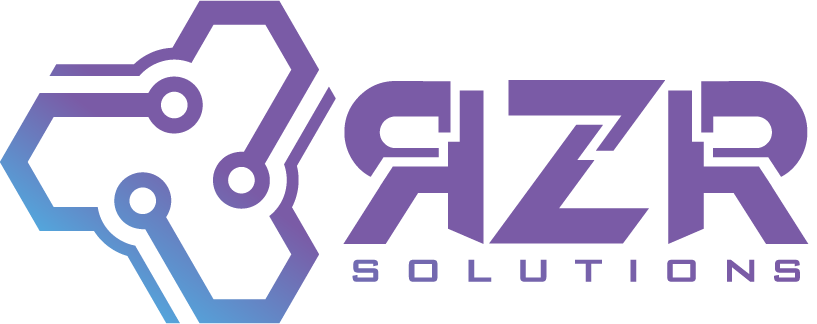Running a small business in North Texas comes with its unique set of challenges, especially when it comes to IT and remote work security. Many entrepreneurs find themselves juggling multiple software solutions while grappling with cybersecurity threats and the complexities of remote work.
Are you struggling to manage your team’s productivity from afar or worried about the vulnerabilities of your network? You’re not alone. Every day, small businesses face the daunting task of securing sensitive data and ensuring seamless communication among dispersed teams. That’s where RZR Solutions steps in. We specialize in tailored IT solutions designed specifically for small businesses, providing the support you need to navigate these complexities with confidence. From implementing strong cybersecurity measures to optimizing remote workflows, we empower you to focus on what you do best—growing your business—while we handle the tech. Discover how RZR Solutions can transform your remote work security challenges into a streamlined, secure framework that fosters success.
VPN Setup and Best Practices
Why VPNs Matter for Remote Work Security
Virtual Private Networks (VPNs) have become critical tools for protecting remote work environments and enabling secure connections for distributed teams. The primary purpose of a VPN is to create a safe, encrypted connection between a user’s device and the internet. This protection is especially crucial in a world where remote work is increasingly common.
As of 2023, studies have shown that over 80% of remote workers rely on VPNs to secure their data during remote access (Statista, 2023). This statistic underscores how important it is to implement robust VPN setups and follow best practices consistently.
Selecting and Configuring the Right VPN
When establishing a VPN for your distributed team, the first step is selecting the right VPN service. Organizations should consider providers that offer strong encryption protocols, such as OpenVPN or IKEv2. These are among the most secure options available and help keep data safe in transit. RZR Solutions can assist businesses in selecting the right service based on their specific needs, budget, and security requirements.
Once the VPN service is chosen, proper configuration becomes the next critical step. This process includes setting up secure authentication methods to ensure that only authorized users can access the network. Multi-factor authentication (MFA) adds another layer of security, making it much harder for malicious actors to breach the network. These security measures protect sensitive company data and increase overall trust within the organization.
Keeping VPNs Updated and Monitored
Another best practice involves regular software updates for the VPN client and firewall settings. Cyber threats evolve quickly, and outdated software leaves gaps that attackers can exploit. Keeping security software up to date helps guard against known vulnerabilities. RZR Solutions provides ongoing IT support to ensure that your VPN systems are regularly updated, patched, and monitored for potential threats.
Monitoring VPN activity is also essential for maintaining security. Logs of VPN connections can help identify unusual access patterns that might signal a security breach. Organizations should regularly review these logs and investigate anything suspicious. When RZR Solutions is engaged, we can help set up automated monitoring systems that send real-time alerts when the system detects unusual activity.
Training Employees on VPN Usage
Employees must also understand how to use the VPN correctly. RZR Solutions offers training programs that teach remote workers how to connect safely, recognize phishing attempts, and avoid public Wi-Fi risks. According to a report from the Cybersecurity & Infrastructure Security Agency, 20% of organizations have noted that human error significantly contributes to data breaches (CISA, 2023). By providing clear training and easy-to-follow resources, companies can empower employees to act as a strong first line of defense against potential threats.
In some cases, organizations may choose to implement split-tunneling in VPN settings. Split-tunneling allows users to decide which applications route their data through the VPN and which can access the internet directly. This feature can improve speed and performance for non-sensitive activity, while still maintaining security for critical data transfers. However, organizations must evaluate which applications to include carefully, weighing the risk of potential exposure against the performance benefits.
Strengthening VPN Strategy for Distributed Teams
In conclusion, VPN setup and best practices are essential to securing distributed teams in the remote work landscape. By selecting a reliable VPN service, keeping software updated, monitoring activity, educating employees, and evaluating configuration options like split-tunneling, organizations can significantly strengthen their remote work security posture. RZR Solutions provides comprehensive support in these areas, enabling businesses to focus on core operations while remaining secure in a challenging digital environment. As remote work continues to grow, employing VPN best practices will protect company data and employee privacy, leading to a more secure and resilient organization.

Securing Home Office Networks
Why Home Networks Are a Weak Link
As remote work continues to become the norm for many organizations, the security of home office networks has emerged as a critical component of a secure and efficient operating environment. With a substantial increase in remote teams—according to a survey by Stanford University, approximately 42% of the U.S. workforce was working remotely as of September 2020—companies must adapt their cybersecurity strategies to protect sensitive data and maintain operational integrity.
One of the primary concerns for organizations is that home networks are often less secure than corporate environments. A survey by the Cybersecurity and Infrastructure Security Agency (CISA) found that about 80% of cybersecurity incidents occur due to weak or misconfigured home network security. Many remote employees never change default router settings or enable basic protections. That lack of attention creates openings for cybercriminals. This reality underscores the need for both companies and employees to prioritize home network security as part of their overall remote work security strategy.
Strengthening Wi-Fi and Router Security
Effective home office network security starts with securing the Wi-Fi network. Employees should be encouraged to change the default username and password for their routers, create strong unique passwords, and enable WPA3 encryption when available. These simple steps prevent unauthorized access to the network and help protect sensitive data passing through the connection.
RZR Solutions provides comprehensive guidance and support for organizational teams as they implement these security measures. We help employees understand why securing their home Wi-Fi matters and walk them through the steps to do it properly.
Using VPNs and Managing Software Updates
Another critical aspect of home office security is the use of Virtual Private Networks (VPNs). VPNs create secure, encrypted tunnels for data traveling between remote employees and the company’s systems. A VPN not only protects data from interception during transmission but also masks the user’s IP address, adding a layer of privacy. According to a report by Global Market Insights, the VPN market size was valued at over USD 30 billion in 2020 and is expected to grow significantly. This growth reflects a rising awareness of secure online practices among remote workers.
Regular software updates and patch management are just as important. Many employees delay or ignore updates for operating systems, applications, and security tools. Those delays leave known vulnerabilities unpatched. A report from the Cybersecurity & Infrastructure Security Agency notes that unpatched software is one of the most common paths for cyber attacks. Organizations should promote a culture of regular software checks and may even provide tools that automate updates and patching. RZR Solutions offers policies, tools, and solutions that streamline software maintenance for remote teams, reducing exposure to security risks.
Educating Employees on Home Network Security
Employee education is a powerful tool for strengthening home network security. Training sessions that cover cybersecurity best practices, phishing awareness, and the importance of secure passwords can dramatically reduce risks. A 2021 report from IBM found that organizations with robust security training are 64% less likely to experience a data breach.
RZR Solutions emphasizes the importance of ongoing training and provides organizations with tailored educational programs. These programs help instill a security-first mindset in remote workers and make secure behavior part of everyday routines, not a one-time event.
Building a Secure Home-Office Foundation
In conclusion, securing home office networks is vital to protecting distributed teams in the remote work landscape. A multifaceted approach that includes secure Wi-Fi practices, VPN usage, regular software updates, and consistent employee education is essential for safeguarding data. By partnering with services like RZR Solutions, organizations can strengthen their strategies and ensure that remote employees have the tools, resources, and knowledge necessary to maintain secure networks in their home offices and support overall remote work security.

Device Management for Remote Workers
The Challenge of Securing Remote Devices
In an increasingly digital era, the rise of remote work has introduced a unique set of challenges around device management. Effective device management is pivotal to maintaining the security of a distributed workforce while still allowing for flexibility and productivity. Remote workers often rely on a mix of personal devices and company-issued laptops, smartphones, and tablets to access sensitive information. That mix makes it critical for organizations to implement comprehensive device management strategies as part of their remote work security plan.
One of the primary concerns in managing devices remotely is the potential for data breaches. According to a report by IBM, companies with remote workers face an 87% higher likelihood of a data breach due to unprotected devices (IBM Security, 2021). To reduce this risk, organizations should adopt Mobile Device Management (MDM) solutions and integrate them into their cybersecurity framework. MDM platforms provide features such as device tracking, remote wipe capabilities, and policy enforcement, allowing IT teams to respond quickly when they detect suspicious activity.
Device Compliance and Industry Regulations
Another significant aspect of device management is maintaining compliance with regulatory standards. Each industry has its own set of security requirements, and businesses must ensure every device that accesses sensitive data meets those standards. For example, healthcare organizations must comply with HIPAA regulations, which require securing any device that processes or stores patient information. Financial and legal industries face similar obligations.
RZR Solutions provides expert guidance to help organizations navigate these compliance challenges. We assist in designing and implementing device management protocols that keep devices compliant without disrupting day-to-day work. This support can include mobile policies, encryption requirements, and regular compliance checks.
Training Remote Workers to Manage Devices Safely
Technology alone is not enough. Organizations must equip their remote workers with the tools and knowledge needed to manage devices securely. Regular training and updated resources can significantly reduce the risk of human error, which is often the weakest link in cybersecurity. Training modules should cover best practices for device security, including recognizing phishing attempts, using secure connection methods such as VPNs, and maintaining strong password hygiene.
RZR Solutions offers specialized training sessions designed to empower remote teams. These sessions show employees how to protect their devices and the data they access, using real-world examples and practical steps they can apply right away.
Zero-Trust Security and Device Inventory
Implementing a zero-trust security model can further enhance device management for remote workers. In a zero-trust approach, the organization never assumes trust based on location—whether the connection comes from inside the office or a home network. Every user and device must prove its identity and meet security requirements before accessing company data. This model requires continuous monitoring and frequent verification but significantly reduces the risk of unauthorized access.
RZR Solutions helps businesses adapt to a zero-trust architecture. We assist in creating policies that verify devices, enforce compliance, and log access for future review. As part of that effort, keeping an inventory of all devices used by remote workers becomes crucial. An accurate inventory allows organizations to monitor performance, security posture, and compliance status across the entire fleet.
Regular audits can identify devices that may pose risks, such as those running outdated software or missing essential security patches. RZR Solutions can help set up monitoring systems that maintain an accurate and current inventory, giving leaders confidence that they understand their device landscape.
Building a Strong Device Management Program
In summary, managing devices for remote workers requires a blend of technology, training, and clearly defined policies. Organizations must prioritize device security to fend off data breaches and maintain compliance with regulations. By leveraging services offered by experts like RZR Solutions, businesses can streamline device management and create a secure, efficient remote working environment. With the right tools and training in place, organizations can empower their distributed teams while safeguarding sensitive information and supporting long-term remote work security.

Cloud Security for Remote Teams
Why Cloud Security Is Central to Remote Work
In today’s fast-paced business environment, remote work has matured from a temporary solution into a permanent workforce strategy. This shift has elevated the importance of cloud security, especially as teams rely heavily on cloud-based tools for collaboration and communication. Cloud security for remote teams is a core part of remote work security because so much sensitive data, communication, and workflow now lives in the cloud.
According to a study by Gartner, 80% of organizations are projected to shift to cloud-centric security within the next two years. They are doing this because cloud-based security often provides more agility and better visibility than traditional approaches, especially for distributed teams.
Access Controls, MFA, and Encryption
Cloud security for remote teams involves practices and technologies designed to safeguard data, applications, and infrastructure stored in the cloud. As employees access information from various locations and devices, strong access controls become essential. Organizations must adopt solutions like multifactor authentication (MFA) to ensure that only authorized users can access corporate resources. MFA adds an extra step to the login process but dramatically reduces the risk of unauthorized access.
Data encryption plays an equally important role. When data is encrypted, even if it is intercepted during transmission or accessed without permission, it remains unreadable without the decryption key. Many data breaches occur because attackers exploit weak or stolen credentials. Encryption helps limit the damage when those incidents occur.
Continuous Monitoring and Threat Awareness
RZR Solutions offers comprehensive cloud security services tailored to the needs of organizations with distributed teams. By partnering with us, organizations can implement security frameworks that follow best practices for cloud environments. These frameworks often include regular assessments of security protocols, employee training on safe cloud usage, and continuous monitoring of the cloud environment for potential threats.
As more businesses adapt to remote work, the rise of sophisticated cyber threats poses a growing challenge. Cybercriminals increasingly target remote workers with tactics like phishing and social engineering that exploit human vulnerabilities. A report from Cybersecurity Ventures noted that ransomware attacks were expected to occur every 11 seconds by 2021, a trend that highlights the need for proactive cloud security measures.
Zero Trust for Cloud-Based Work
To combat these threats effectively, organizations must build a culture of cybersecurity awareness among remote employees. RZR Solutions emphasizes regular training and ongoing updates about current threats and attack patterns. Empowered with knowledge, employees are more likely to recognize suspicious activity and avoid risky behavior.
Organizations should also consider adopting a zero-trust security model for cloud environments. Under zero trust, no user or device—inside or outside the company network—is considered trustworthy by default. Every access request is verified before permissions are granted, and systems continuously re-evaluate whether each user still meets the security requirements.
Creating a Secure Cloud Foundation for Remote Teams
In conclusion, as remote work becomes a staple across industries, robust cloud security for distributed teams has never been more critical. By investing in solutions like MFA, strong access controls, encryption, and continuous training, organizations can safeguard their digital assets. RZR Solutions can assist in designing and implementing a secure cloud infrastructure, enabling companies to focus on their core business while remote teams work confidently and securely. With the right cloud security measures in place, organizations can strengthen their overall remote work security posture and reduce the risk of costly incidents.

Training Remote Employees on Security
Why Human Error Drives So Many Breaches
In today’s work environment, remote teams are becoming increasingly common. With this shift, organizations face unique security challenges. One of the most crucial aspects of maintaining a secure remote workforce is comprehensive security training for employees. As staff members move from traditional office settings to remote work, they must be equipped with the knowledge and tools necessary to protect sensitive information and maintain the integrity of the company’s digital infrastructure. This kind of training forms a foundational part of any serious remote work security program.
Research conducted by IBM shows that human error accounts for approximately 95% of cybersecurity breaches. This staggering statistic highlights why thorough security training for remote employees is not optional. Organizations must prioritize education about threats such as phishing attacks, credential theft, and poor data-handling habits. Remote workers might inadvertently expose company data when they use unsecured Wi-Fi networks, reuse weak passwords, or share devices with family members.
Building an Ongoing Security Training Program
Security training for remote employees should be comprehensive and ongoing. A single training session at onboarding is not enough. Organizations need regular refresher courses and periodic updates that address new security threats and evolving attack tactics. RZR Solutions offers tailored security training programs that cover password management, phishing recognition, safe browsing habits, and secure use of collaboration tools. These programs help increase employee awareness and encourage a culture where security is part of everyday work.
One effective approach to training remote teams is to use interactive, hands-on learning. Traditional slide presentations often fail to keep remote employees engaged. Simulations, quizzes, and scenario-based exercises give employees a chance to practice what they learn. RZR Solutions can create customized training modules that incorporate these interactive elements, making it easier for employees to internalize critical concepts.
Security Hygiene and Clear Response Processes
Another key element of training is emphasizing basic security hygiene. Employees should understand why strong, unique passwords matter, how to use multi-factor authentication (MFA), and why reusing passwords across multiple systems is risky. According to a study by the Identity Theft Resource Center, about 80% of data breaches could be prevented with proper password management. Training that reinforces these habits can make a measurable impact on remote work security.
Organizations should also establish clear communication guidelines for security incidents. Employees need to know who to contact when something seems suspicious, what steps to take if they suspect a breach, and how to report potential vulnerabilities. RZR Solutions helps organizations develop response plans and communication frameworks so employees are not left guessing during critical moments.
Creating a Culture of Security Awareness
Finally, fostering a culture of security awareness is essential for long-term success. Leadership should support and reinforce security initiatives, not treat them as a box-checking exercise. Regular communication about security updates, sharing best practices, and recognizing good security behavior can all help build that culture. When employees see that leadership takes security seriously, they are more likely to follow suit.
In conclusion, training remote employees on security is essential for protecting sensitive data and maintaining a strong cybersecurity posture. With 95% of breaches attributed to human error, a structured educational approach that includes interactive training, emphasizes hygiene, and sets clear response protocols is critical. RZR Solutions is committed to providing comprehensive training programs that empower remote teams and prepare them to face cybersecurity challenges head-on. By investing in security education, organizations can significantly reduce risk and strengthen their overall remote work security landscape.
Conclusion: Remote Work Security for Distributed Teams
Remote work security is now a core requirement for any organization that relies on distributed teams. Implementing a comprehensive strategy that includes VPN best practices, secure home office networks, strong device management, cloud security, and ongoing employee training can drastically reduce vulnerabilities.
When organizations establish secure communication channels, enforce strong password and MFA policies, and foster a culture of awareness, they create a safer environment for both data and people. By prioritizing these measures, leadership can build a secure remote working environment that supports productivity, protects sensitive information, and reduces the risk of costly security incidents.
Need IT Solutions?
Call: 972-904-1559 •
Book Consultation

